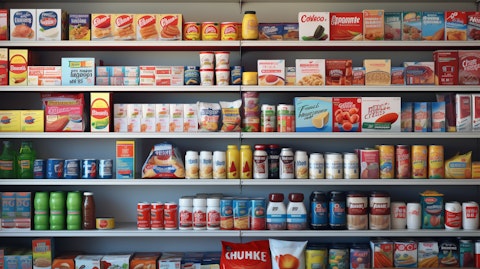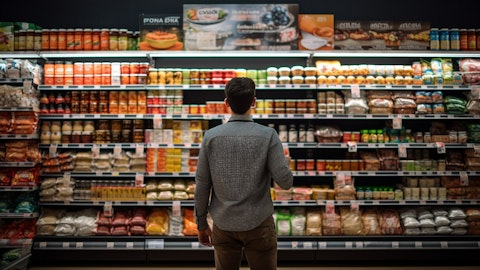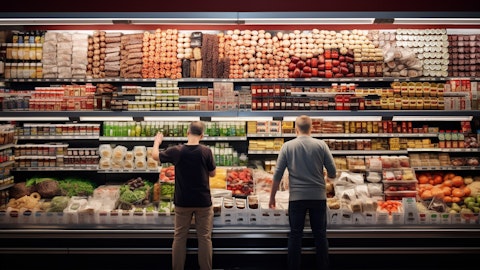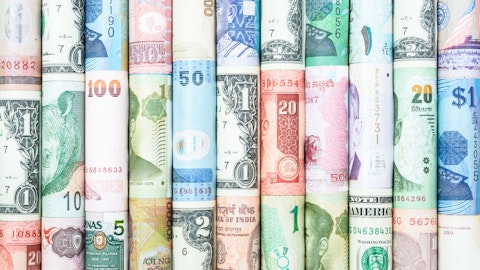Unilever PLC (NYSE:UL) Q4 2023 Earnings Call Transcript February 8, 2024
Unilever PLC isn’t one of the 30 most popular stocks among hedge funds at the end of the third quarter (see the details here).
Hein Schumacher: Good morning, and welcome to Unilever’s Full Year Results. I’m delighted to be here today with our new Chief Financial Officer, Fernando Fernandez, who, as you know, took over the role on the 1st of January. Fernando may be new to the role but not, of course, to Unilever, having previously served as President of our Beauty & Wellbeing business group, and before that, as head of Unilever’s business in Latin America. We expect prepared remarks to be around 45 minutes, followed by Q&A of around 30 minutes. And all of today’s webcast is available live, transcribed on the screen. This is how we will run today. In a moment, Fernando will take you through the details of the results and our outlook. I will then give an update of our progress against our Growth Action Plan before we take your questions.
First, though, let me try to frame today’s announcement with a few overall reflections of my own. The results and our performance for last year give some cause for assurance, the strength and the resilience of the business are clear, but not enough cause for comfort. There are some real gaps that we need to close. Most of all, however, they reaffirm the importance and the relevance of the measures we are taking now at pace to accelerate Unilever’s growth and to step up the quality and the consistency of our performance. Those measures were set out in the Growth Action Plan I shared with you at the end of October. But given its importance, I want to devote most of my remarks today to the plan and how we are implementing it. First, though, let me highlight five important shifts that we have already made, some of which are reflected in the results we are sharing with you today.

First, we returned to positive volume growth of 1.8% in Q4 and gross margin expansion of 330 basis points in the second half. Second, we tightened grip on operations and working capital leading to strong free cash flow. Third, we stepped up brand and marketing investment focused on the 30 Power Brands. Fourth, we made significant changes in our Ice Cream business to address underperformance. And fifth, we accelerated portfolio change with the acquisition of the premium hair care brand, K18, and the disposal in the value segment of Elida Beauty. I will come back to the Growth Action Plan in more detail later, but I wanted to flag these five shifts upfront partly because they are significant in their own right, but also because they’re indicative of the changes that we are making, changes that we need to make, and we know that.
Our competitiveness bottomed out, but remains unacceptably low. So we are not waiting to take the action that is needed. And on that note, let me hand over to Fernando to take you through the results. Fernando, over to you.
Fernando Fernandez: Thank you, Hein. I am very happy to be here with you today for the first time as Unilever Chief Financial Officer. Let me introduce myself. I joined Unilever in Argentina as an economist in the finance function. For the last 16 years, I have led some of our key operations like the Philippines, Brazil and Latin America. More recently, I was the President of the Beauty & Wellbeing business group. My long experience high-growth businesses, particularly in volatile markets, has always been anchored in one fundamental belief: drive brand and product differentiation to grow volume, positive mix and to expand gross margin consistently. That recipe never fails in delivering long-term competitive success, and it is the one we will ruthlessly follow.
See also 25 Best States for Job Seekers Right Now and 25 Least Family-Oriented Countries in the World.
Q&A Session
Follow The Unilever Group (NYSE:UL)
Follow The Unilever Group (NYSE:UL)
I am excited to partner Hein in embedding the Growth Action Plan to improve our financial performance, our competitiveness and drive significant value creation. That said, let’s get into our 2023 results. Full year 2023 underlying sales growth was 7% with all our business groups delivering growth. Price contributed strongly at 6.8% and volume returned to positive territory at 0.2%. The 30 Power Brands were growth accretive with 8.6% underlying sales growth and 1.6% volume growth. Along the year, we have seen a steady decline of price growth rates as cost inflation eased. Fourth quarter growth was 4.7%, with a significant step-up in volume growth to 1.8% and with price at 2.8%. Three of our 5 business groups posted volume growth: Beauty & Wellbeing, Personal Care and Home Care.
The 30 Power Brands grew 6.5% with 3.9% coming from volume. Going forward, we will be laser-focused on driving volume growth and mix as price growth returns to more normalized levels. Beauty & Wellbeing delivered a strong full year performance with good balance between volume and price growth. Underlying sales growth was 8.3%, 4.4% in volume, 3.8% in price. In the fourth quarter, we saw a strong acceleration in volume growth to 6.3%, underpinning sales growth of 7.9%. Our Health & Wellbeing and Prestige Beauty businesses, both with significant exposure to the U.S. market, continued to deliver double-digit volume-led growth. Liquid I.V., Nutrafol, Dermalogica and Hourglass all performed exceptionally well. Combined, Health & Wellbeing and Prestige Beauty now represent 27% of the business group turnover.
Hair ended the year with good momentum and positive volume growth, reflecting strong performances from Sunsilk, TRESemmé and Nexxus, our masstige proposition in the U.S. premium segment. The core skin businesses saw a strong performance for Vaseline, now EUR 1 billion brand, on the back of the Gluta-Hya innovation. Carver’s performance was weak given a necessary reset of our Chinese route to market. Whilst we are disappointed with Carver’s performance, we remain confident in the potential of the AHC brand across Asian markets. Personal Care also had a strong year, driven by mid-teens growth from the Deodorants. Underlying sales growth was 8.9% for the year with 3.2% in volume and 5.5% in price. Fourth quarter growth was 6.4%, with 2.5% volume and 3.8% price.
The global rollout of our 72-hour nonstop protection technology across Dove, Rexona and Axe has given us significant product superiority and strong growth in all 3 brands. It will remain one of our major multi-year growth initiatives. Skin Cleansing grew well with positive volumes despite the slowdowns in India and Indonesia to which I will come back shortly. Dove benefited from the Dove Body Wash improved deep moisture innovation and Dove Men+Care enjoyed strong double-digit growth. Oral Care also grew well in the fourth quarter with solid performances in both Pepsodent and Closeup, particularly in our Asian strongholds. Despite the strong financial performance of our Personal Care business, we are disappointed with the erosion of competitiveness in the U.S., where we have been too slow in responding to the consumer shift to an emerging super-premium segment.
We are taking decisive action to address this issue, but it will not be a quick fix. Home Care saw volumes turning positive in the second half alongside a sharp deceleration in price growth. Underlying sales growth was 5.9% for the year with 6.8% price and 0.9% reduction in volumes. Fourth quarter growth was 1.7%, comprising positive 0.8% volume and 0.9% price. Home Care has a significant exposure to emerging markets where volatile commodities play a disproportionate role in many Asian markets, including our largest, India, we benefited during the upward trend of commodities with several local players in the value segment struggling. Now with falling commodity prices, they are returning to the market, putting pressure on prices. We are and we will defend our position, and this explain the sharp deceleration of pricing we have seen as the year progressed.
Fabric enhancers and Home & Hygiene also grew with good performances in Latin America, Turkey and the successful introduction of the Domestos Power Foam in Europe. This is another example of premium innovation based on differentiated technology, which will drive both category growth and improvement in competitiveness. Hein will come back to this theme shortly. Nutrition delivered price-led growth in 2023 as the business responded to higher input costs. Nutrition grew 7.7% in the year with price up 10.1% and volumes down 2.2%. Fourth quarter growth was 4.7% with price up 5.9% and volume down 1.1%. The main drag on volume was in Europe where we have aggressively rationalized our assortment through the delisting of unprofitability items and where we continue to see the impact of consumer down-trading to private label.
The two largest brands, Knorr and Hellmann’s, which together represent 60% of the business group, grew well in the fourth quarter with positive volume. Knorr surpassed the EUR 5 billion milestone for the full year. And Hellmann’s benefited from the continued success of their vegan and flavor ranges across key markets. Our professional Food Solutions business delivered a strong double-digit growth throughout the year. The business has now returned to prepandemic volumes with value well ahead. Ice Cream grew 2.3% a year with 8.8% price growth and a 6% decline in volume. The fourth quarter saw underlying sales growth of minus 0.4% with price growth slowing to 0.4% and a volume decline of 0.8%. It has been a very disappointing year for Ice Cream with price elasticity in the in-home channel much more negative than that seen in other categories and with a strong consumer down-trading to private label.
We are taking actions to restore competitiveness in the category. And we start to see benefits of a sharpened pricing and promotional strategy in the United States that brought in-home volumes back to positive territory in the fourth quarter. A difficult year calls for reflection and then action. We have put in place a new leadership team led by Peter ter Kulve, who has great experience in the category. This team is reviewing the end-to-end economics of the business with the goal of improving operational grip and productivity. This completes the review of the business group performance. Let me now reflect briefly on the fourth quarter performance through a regional lens. Our largest region, Asia Pacific Africa grew 1.9% in the quarter with 0.7% volume and 1.1% price.
It is a testament to our strength in depth in emerging markets. Now we have been able to deliver positive growth in Asia Pacific Africa region despite some headwinds in important markets like India and Indonesia. In India, Hindustan Unilever remains a powerhouse with strong brands and rival distribution and exceptional talent. As has happened many times in the past, the business is navigating a commodity cycle aiming to strengthen our long-term competitive position. We have decisively adjusted prices in categories more sensitive to commodity cost deflation such as fabric cleaning and skin cleansing bars. The outcome was a flat top line in quarter 4, but with volumes coming back to the long-term growth trajectory and improving gross margin. We will continue investing behind our brands and capabilities even if price is expected to remain negative in the near future.
In Indonesia, we saw a double-digit sales decline in the fourth quarter as sales of several multinational companies were impacted by geopolitically focused consumer-facing campaigns. The impact was significant in December, but we are managing the situation well and began to see an improvement in our January sales. Europe grew 2.5% in the quarter with price up 9.4% and volume down 6.3%. With a large exposure to Nutrition and Ice Cream, we suffer from the consumer down-trading to value. We have also consciously removed a significant number of unprofitable SKUs making us leaner and sharper. This impacted volumes and market share, but with a positive mix contribution to gross margin. North America grew 7% in the quarter with volume up strongly at 6.3%.
This was a great performance driven by positive volumes in all business groups, and in particular, the strong performance of the brands acquired over recent years in our Health & Wellbeing and Prestige Beauty businesses. I don’t want to sound biased, however, let me say that Latin America remains a real Unilever stronghold. The region grew 13.4% in the quarter, successfully navigating the commodity cycle with a pivot from price-led growth to a strong volume growth of 9.1%. This reflects a well-positioned portfolio and the strength of both our brands and our in-market execution across the region. A key feature of the financial statements in 2023 is the negative impact of currency, both at top and bottom line. This was driven by the weakness of most currencies against the euro.
Not only were the emerging market currencies down, led by Argentina, India and Turkey, but the U.S. dollar also saw a negative impact. Turnover for the year was EUR 59.6 billion, down 0.8% versus 2022. Underlying sales growth contributed 7%. And we saw a negative impact from acquisitions and disposals of 1.7% with the disposals of tea and Suave, partially offset by the inclusion of Nutrafol and Yasso. Currency had a negative impact of 5.7% on turnover. And if currencies remain they were at the end of January, the currency impact on full year 2024 turnover would be around minus 2% and around minus 5% on underlying earnings per share. This will no doubt change, and we will update you as the year unfolds. Underlying operating margin for the year was 16.7%, up 60 basis points versus 2022.
The gross margin expansion of 200 basis points allowed us to significantly increase our brand and marketing investment by 130 basis points to 14.3% of turnover. That investment in our brands focused behind strong superior innovations is a fundamental reason behind the acceleration of volume growth in the second half. The 10 basis points increase in overheads reflect continued investment in R&D and key capabilities. Three business groups increased underlying operating margin, personal Care, Home Care and Nutrition, whilst Beauty & Wellbeing was flat as we keep investing behind our fast-growing Prestige and Health & Wellbeing businesses. Ice Cream was down 90 points, reflecting the gross margin impact from continued cost inflation and volume deleverage.





